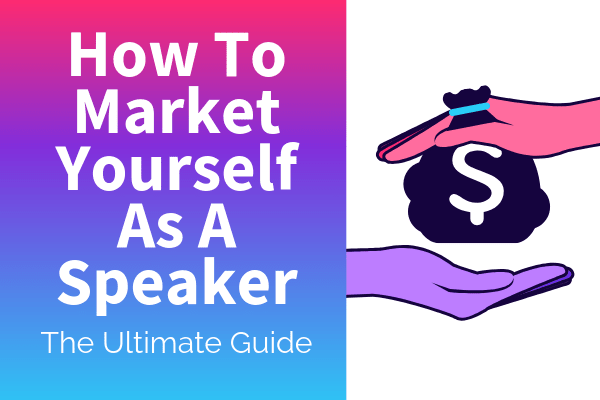The ultimate goal as a business owner is to bring more positive attention to your business. That said, whether it’s through advertising, networking, or content, it’s no secret that this isn’t easy. Similarly, there are many ways to gain exposure for your speaking business, all of which are constantly evolving. In light of this, let’s break down the ways to effectively market yourself as a speaker.
Currently, speaking business marketing is concentrated primarily in the digital world. Over the last decade, we’ve seen these changes for several reasons. However, many of these reasons still have yet to be fully utilized in the speaking space. Website analytics and tracking, for example, are two huge pieces of digital marketing that not only bring new clients. They also allow you to quickly analyze and adjust your marketing processes where needed, reducing cost in the long run.
From implementing these on our website to testing new marketing ideas at SpeakerFlow, we’ve seen firsthand the benefits of learning to market yourself as a speaker. Now, I’m here to share it with you in this ultimate guide. Below are the main marketing topics we’ll cover.👇
Creating & Maintaining A Speaker Website
First and foremost, let’s talk about websites. As far as marketing is concerned, if you don’t already have a website, this is your top priority. Without a website, not only are you unable to attract potential clients through other marketing channels, such as paid advertising. You’re also unable to showcase your credentials and speaking experience without having a conversation. As a speaker, the latter is especially important because of your busy schedule. After all, if you’re bouncing from event to event and trying to make sales in between, you don’t have a lot of time to spare. A website allows event planners to find you and get a sense of whether they want to hire you within a quick glance. Because of this, to market yourself as a speaker, a website is key.
On the flip side, if you already have a website, refreshing or rebranding it can be equally useful. Besides updating your list of past clients, redesigning your website allows you to put a new face on your speaking business. Still using stock photos from the early 2000s? Is your website mobile friendly and designed to adapt to different devices? These are just two reasons, among many, to give your website a facelift and get it up to speed with today’s design trends.
Designing Your Personal Brand
That said, before rebranding your website, it’s important to focus internally. Because speaking businesses are highly personal, rebranding or creating your brand has to represent you. This means that in working to market yourself as a speaker, you have to first define how you want people to see you as a person.

Ultimately, your personal brand should encapsulate your traits, values, and audience. Identifying your traits is arguably the easiest of these and involves your appearance as well as your actions. For example, looking at George Clooney, we see by his body language and tone that he is self-assured but approachable. In his attire, we see his class. In the same way, look at your own brand and comportment and ask yourself, “What words do I want people to use when describing me and my speaking business?” These words tie in closely to your values, the key issues and topics that are important to you and your stance on each one.
Finally, the last step of your personal brand is identifying your audience. When you begin to market yourself as a speaker, the more efficient path to prosperity is specificity. Look at your character traits and your personal values and ask, “Who can benefit from my knowledge the most?” In some cases, there can be a variety of industries waiting to benefit from your work. However, it’s important to narrow your focus to a few select groups, so you can tailor your marketing efforts to them later on. One of the most common phrases our chief marketing officer, Taylorr, throws around is “niches lead to riches” and he’s right! The more specific your focus, the more efficiently you can explain your value to the people in question and the more easily you can sell your services.
Recommended Branding & Design Services
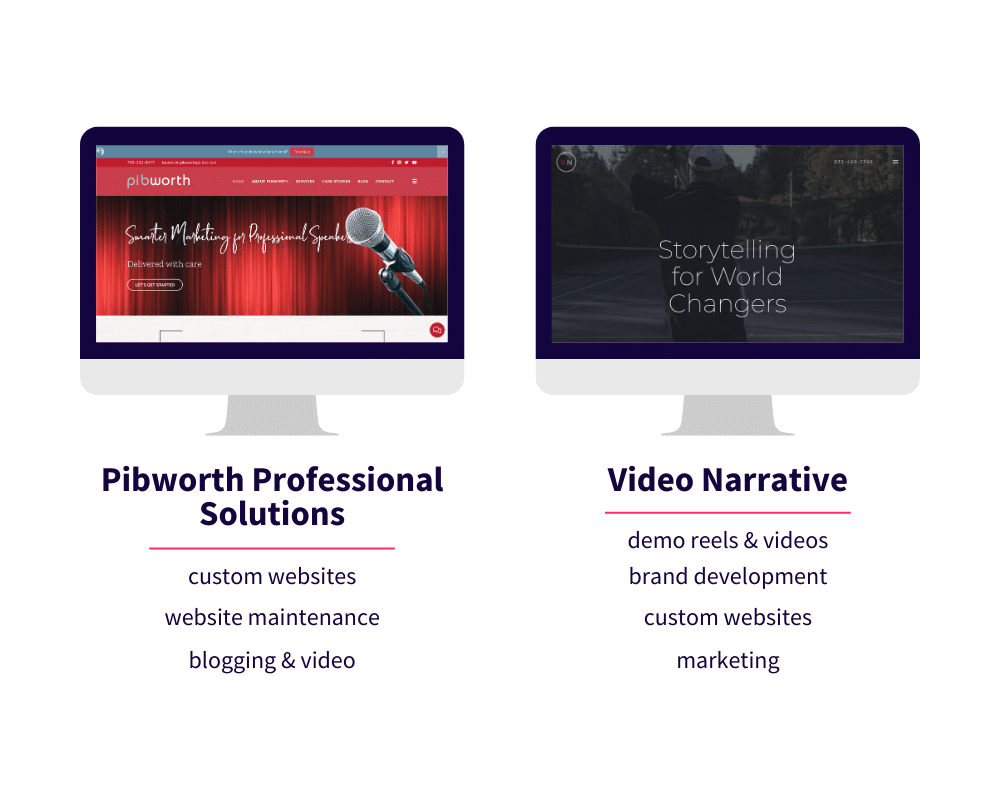
Once you’ve outlined your personal brand, it’s time to launch into design. Depending on your comfort level, there are a few options for creating or redesigning your website. The first option is hiring a design firm to do the work for you. Although this can be expensive, working with professional web designers comes with many benefits. For one thing, they know the technical side of building or changing websites better than many speakers do. There are, of course, exceptions to this rule, but for many speakers, the back end of their website can be difficult to navigate. Additionally, besides the technological hurdles, web designers are also helpful in their design skills. Again, there are many exceptional speakers to this rule, but in the average speaking business, the owner doesn’t have the knowledge of current design trends to tackle their website with ease. Plus, they don’t have the time!
If you’re reading this thinking that you fit into one (or more) of these categories, the good news is that there are several options out there to take the work off your plate. Within the speaking industry, two of our favorites at SpeakerFlow are Video Narrative and Pibsworth Professional Solutions. In addition to their other services, the employees at each of these companies are extremely well-versed in personal branding. They also have extensive knowledge of the speaking industry so, when you’re ramping up your efforts to market yourself as a speaker, they can help immediately.
In addition to branding, Video Narrative and Pibsworth Professional Solutions provide website design services. We’ll break down a few examples, along with a few of our other recommended web design firms, shortly. 👍
DIY Branding & Design Tools
Before we get into choosing a team to do it for you, what if you want to do it yourself? All of us at SpeakerFlow are huge fans of the DIY approach to marketing. As a result, we’ve not only come across the marketing techniques we’ll cover later in this guide. We’ve also found some incredible DIY design tools.
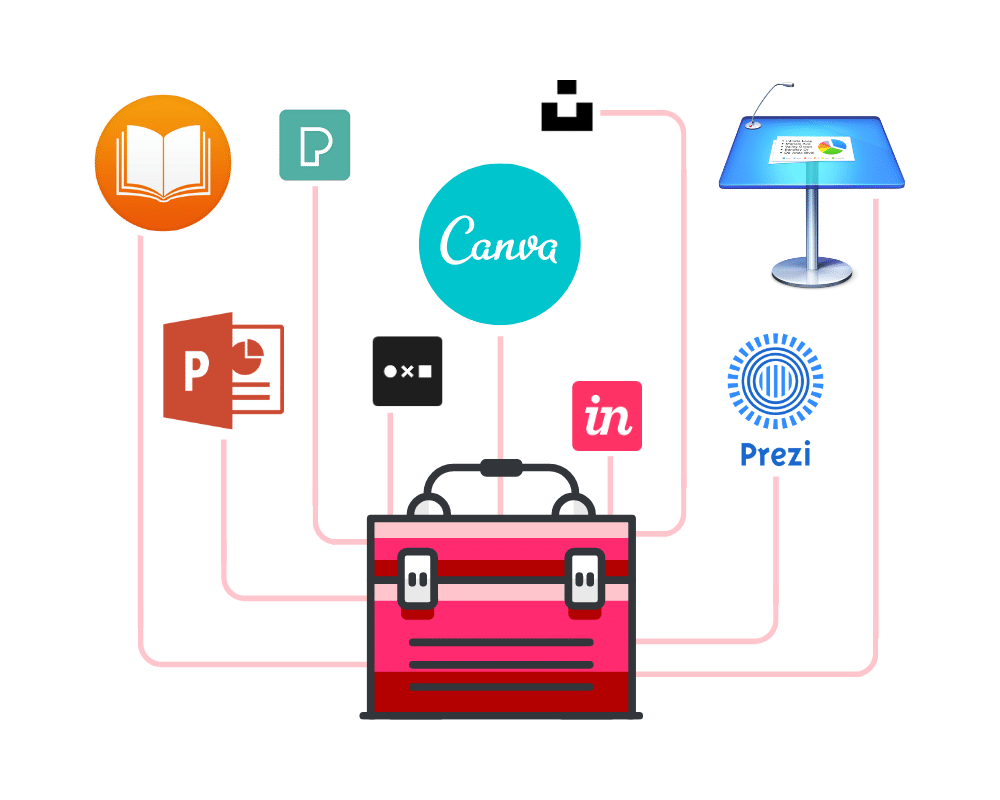
Of these tools, by far, the one that I use the most, as SpeakerFlow’s graphic designer, is Canva. Launched in 2012 in Sydney, Australia, Canva’s mission is “to allow you to design anything and publish anywhere”. Available on desktop and mobile devices, it’s definitely one of the most accessible design options for speakers. Additionally, with an intuitive interface and thousands of templates, it makes it easy to peek into the world of graphic design. That way, even with a small budget, you can take control of your brand. You can also handle a large variety of branding projects, including business cards, flyers, and social posts. Basically, if you can think of a project, Canva likely has a template for it. Plus, it starts for free!
Combine Canva with photos, and you can bring designs together in minutes. Although photography from your own events is preferable, through sites like Unsplash and Pexels, not only can you find high-quality photos (in other words, not the cringe-worthy images of smiling models from the 1990s). You can also find high-resolution images available for free. In the context of design, these are especially important if you want to use them on your website or a large printed project.
For more design tools, check out a few of my other favorites below:
- PowerPoint and Keynote (slide show design for Windows and Mac, respectively)
- The Noun Project (icons)
- InVision Studio (digital design)
- Prezi (interactive presentation software)
Choosing a Domain Host
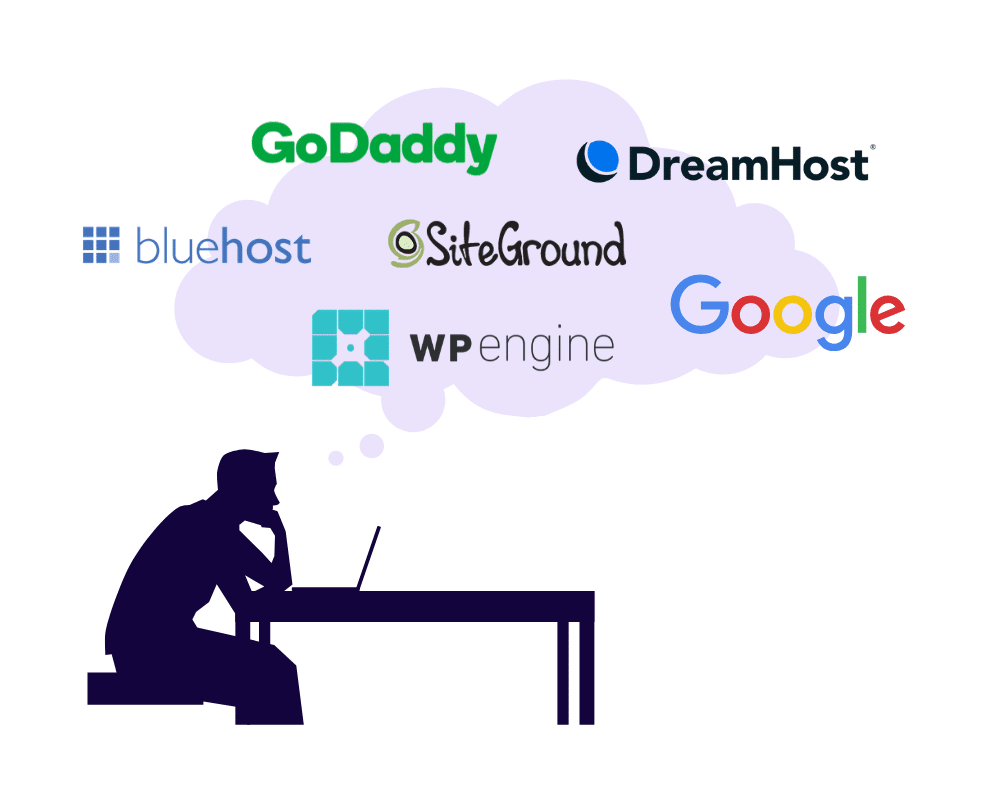
After outlining your brand, it’s time to start the website construction process. The first step in this process is choosing a host for your domain. If you are new to buying and hosting domains, your domain is the string of words, letters, or numbers that you enter in the URL to identify your website. Basically, your domain is the ID for your website, so others online can find it. Your domain registrar is where you buy your domain name, and your domain host is the platform that houses your website’s records and the live version of your website. In some cases, your domain registrar and domain host are managed by the same company. Within the speaking industry, a few common examples of this are Wix and Squarespace. These companies and others that combine domain registration and hosting aim to simplify the process of creating and maintaining your website.
Besides Wix and Squarespace, there are several additional options for combination domain registration and hosting. Among speakers, two of the most commonly used are GoDaddy and BlueHost. Both of these platforms are known for their general ease of use and affordability when it comes to purchasing a domain. Additionally, they also provide 24/7 support, so if you get stuck, you have someone at hand right away. However, what they have in support, they lack in long-term features. For both GoDaddy and BlueHost websites, while they’re easy to build, they generally lack the robust plugins and features available through more expensive building platforms, such as Wordpress. This makes them more difficult to extensively customize and scale with your speaking business. From a security standpoint, GoDaddy also surcharges a minimum of $64 per year for your SSL certificate, giving you less bang for your buck in the long run.
Our Recommendations
So, although these options may be easier in some ways, there are several advantages to learning the domain purchasing and hosting process and managing each area from a separate platform. As website builders ourselves, here at SpeakerFlow, our personal recommendations include Google Domains and Wordpress Engine for domain registration and hosting, respectively. First, when purchasing a domain, Google Domains makes it easy to manage your domain now and as your team expands. It’s also very affordable, with many domains available for as little as $12 per year. The other piece of the puzzle, Wordpress Engine as your domain host, is a little more expensive. However, even at $30 per month, the exceptional security, free SSL certificate, and unlimited backup features are well worth the price. So, if your website is built on Wordpress (again, our favorite website builder based on our experience), Wordpress Engine is the way to go. 👍
Choosing a Website Builder
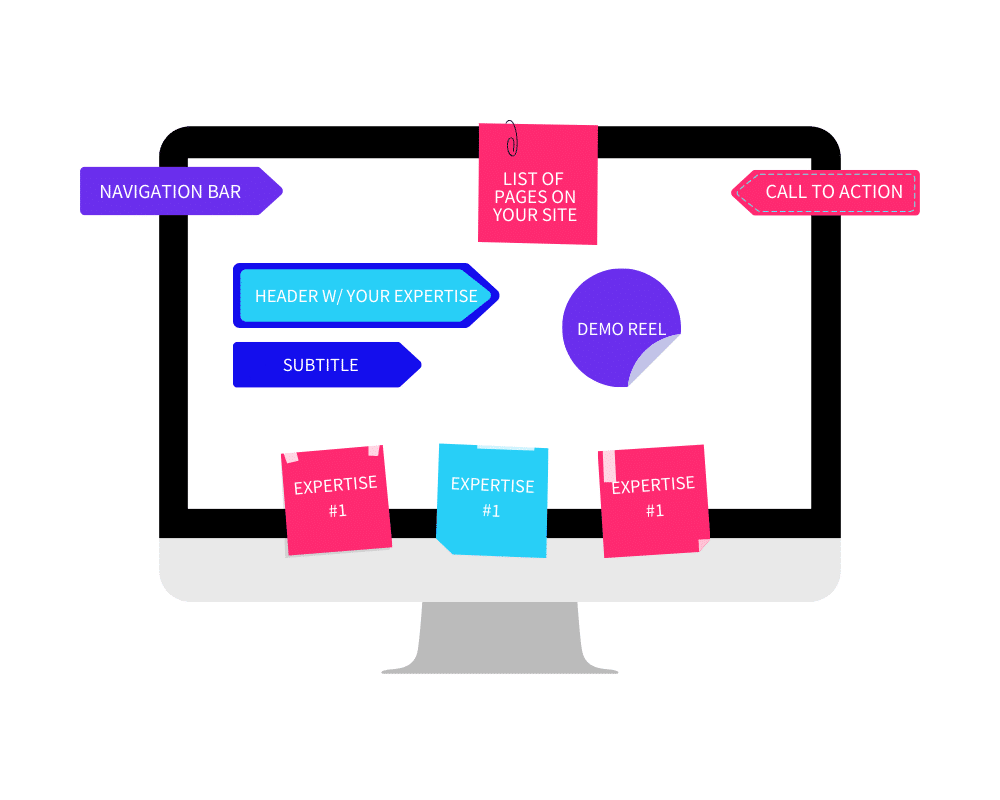
Now that you have your brand and your domain, all that’s left to do is make it a reality by creating your website. As mentioned in the last section, our team favorite, when it comes to web design platforms, in Wordpress. Although we’ve worked on several other platforms, both myself and our lead website guru, Taylorr, come back to Wordpress time and time again for a number of reasons. To begin with, at only $8 per month, it’s an easy-to-navigate and affordable way to design your site your way. It’s also set up from the beginning with tons of themes and plugins, so you can add personality to your website without having to learn to code. For the majority of speaking businesses, this is a huge win, especially since you should ideally know how to manage your site without a developer on hand.
Another reason we gravitate towards Wordpress is their companion tools, including Elementor. Created specifically for Wordpress, Elementor is essentially a drag-and-drop software for building and customizing web pages. Like Wordpress, besides including pre-built themes for you to start with, it also comes with a variety of widgets. These features allow you to add custom fields, animations, and layouts to a page in a single click. They also make it easy for you or another member of your team to edit or update your site, even with very little knowledge of how websites are constructed. Plus, although it’s priced separately from Wordpress, if you hire a firm to build your site for you, they can likely have it added to your site as a part of their standard fee. That way, you get all of the amazing features of Elementor, now and down the line, without blowing your budget.
Recommended Website Design Services
Speaking of website design agencies, there’s no shame in having someone else build your site for you! We’ve covered a ton of reasons and tools for doing it yourself, but not everyone has the patience and time to learn the process of building a website. Additionally, from a design standpoint, a web designer can bring a fresh perspective to your brand.
When looking for that new perspective, two amazing sources of talent and skill have already been covered here, the first of which is Video Narrative. In addition to high-quality branding and videos, the team at Video Narrative is also known for its unique approach to web design. In recent years, one of the most notable examples of this is that of speaker and branding expert Bruce Turkel. Looking at their portfolio, it states, “Bruce has never followed the rules. We knew the website needed to match. This meant that since almost every modern website is built on a clean white template, we need to build his on black. Every element needed to move with elegance”. In the same way, with each website, Video Narrative starts with you and your message and builds your site from there.
At Pibworth Professional Solutions, Lauren Pibworth also takes inspiration from her client’s message when creating their website. With several experienced speakers in her care, her extensive knowledge of how to market yourself as a speaker has resulted in some truly noteworthy websites over the years, including those for including Susan Luke Evans, Beverly Beuermann-King, and Barbara Appelbaum. On a personal note, Lauren’s also just awesome to work with! All of us on the SpeakerFlow can vouch for her friendliness, positivity, and problem-solving attitude, and, with that sort of power behind your site, what could possibly go wrong? 😊
[hubspot type=cta portal=5815852 id=e68abcd9-8ad0-4673-81d2-450b59a97afc]
Building A Social Media Presence
At this point, you have your brand, and you have your website. Now, let’s start bringing people to it! Increasingly over the last few years, because so many event planners and decision-makers search for speakers online, one of the most effective ways to catch their attention is through social media. In addition to posts about your message and area of expertise, maintaining a social presence also shows the world who you are. What companies have you worked with? Do you work nationally or internationally? Are you more of a strict presence on stage or a funny one? Each of these questions can be answered through social posts. However, depending on the social platform you’re talking about, one strategy may be more appropriate than another.
Facebook Strategy Basics
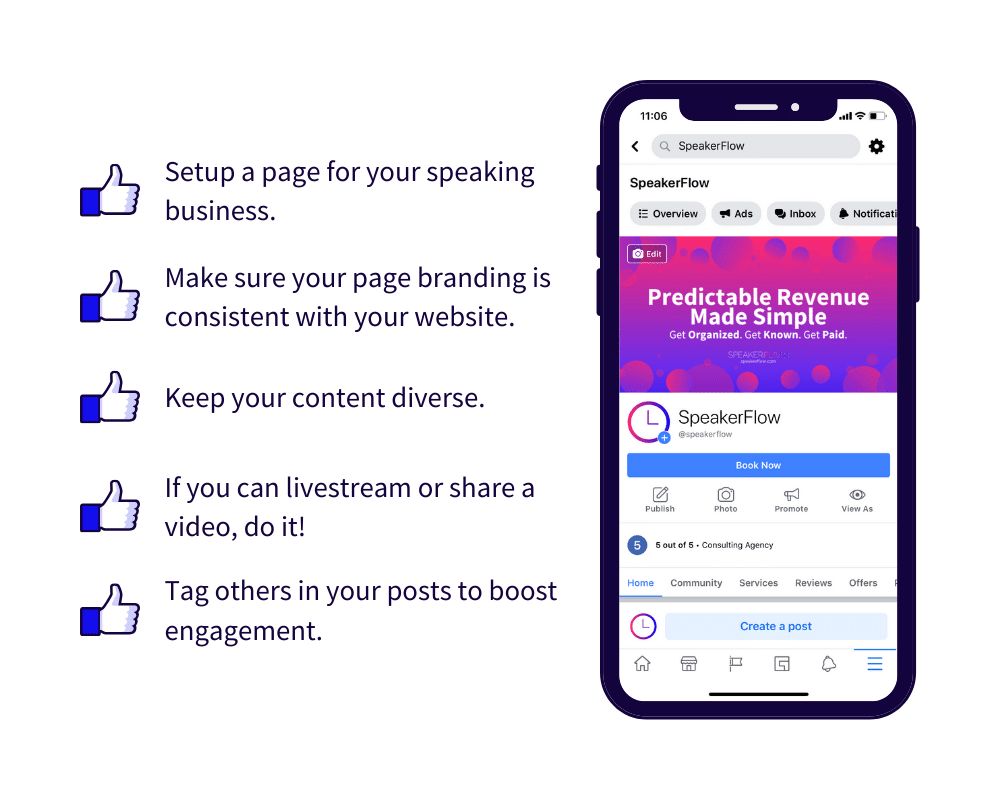
To begin with, let’s look at Facebook. Launched by tech lovers and then Harvard students Mark Zuckerberg, Dustin Moskovitz, Chris Hughes and Eduardo Saverin in 2004, Facebook exploded almost immediately. In fact, by the end of its first year, the platform had over one million users across the world, providing fast and convenient connections on a scale unheard of before. Since then, Facebook has grown to more than 44,000 employees across North America, Latin America, Europe, Middle East, Africa and Asia and more than a billion user profiles. Nevertheless, despite their size, their goals remain the same, including “Give People a Voice,” “Build Connection and Community,” and “Promote Economic Opportunity”.
In the context of speaking, the promotion of economic opportunity is especially important. Because of this, it’s important to strategize your Facebook presence. That way, you can use your Facebook profile for connecting with friends and family and your Facebook page for connecting with potential clients. On your Facebook page, remember three things above all else: be consistent, diverse, and engaging. Consistency is important both where posting and branding are concerned. Essentially, in order to market yourself as a speaker on Facebook, you need to post regularly and keep your posts’ content on-brand.
That brings me to the second tip: diversifying your content. Including images, articles, or videos in your posts is not only eye-catching. It also allows you to share more with your viewer. In the same way, remember, in each post, to engage with people. If you can tag another speaker or client, do it! If you can mention, “Comment your thoughts👇” have at it. The more you can connect with your audience on social media, the more likely one of them will want to be in your audience when you’re on stage, too.
Using Hashtags in Facebook Posts
Another way to attract attention to your Facebook page is through the use of hashtags. Fundamentally, hashtags are words or numbers written without spaces and preceded by the pound (#) symbol. Within the speaking industry, a few commonly used hashtags are #professionalspeaker, #speakingbusiness, and #conferencespeaker, for example. For decision-makers, tracking these hashtags means easily finding speakers for their events. This makes it crucial that you include appropriate hashtags in your Facebook posts. That way, event planners can effortlessly find your Facebook page, see how great you are, and hire you.
For more information about developing a Facebook strategy, check out the articles below.
- “Facebook Marketing for Small Business: How to Grow in 2022 and Beyond” from Buffer
- “16 Tips to Create the Best Facebook Marketing Strategy EVER for 2022” from LocalIQ
- “How Hashtags on Facebook Still Work for Businesses” from SproutSocial
As a side note, Hootsuite, SproutSocial, and Buffer are three tools for scheduling social media posts ahead of time. In the SpeakerFlow team, we use Buffer when we’re at NSA or CAPS events, so we don’t have to miss our daily post, even though we’re on the road. As a speaker, as you’re going from gig to gig, any of these could potentially be helpful for you, too.
Twitter Strategy Basics
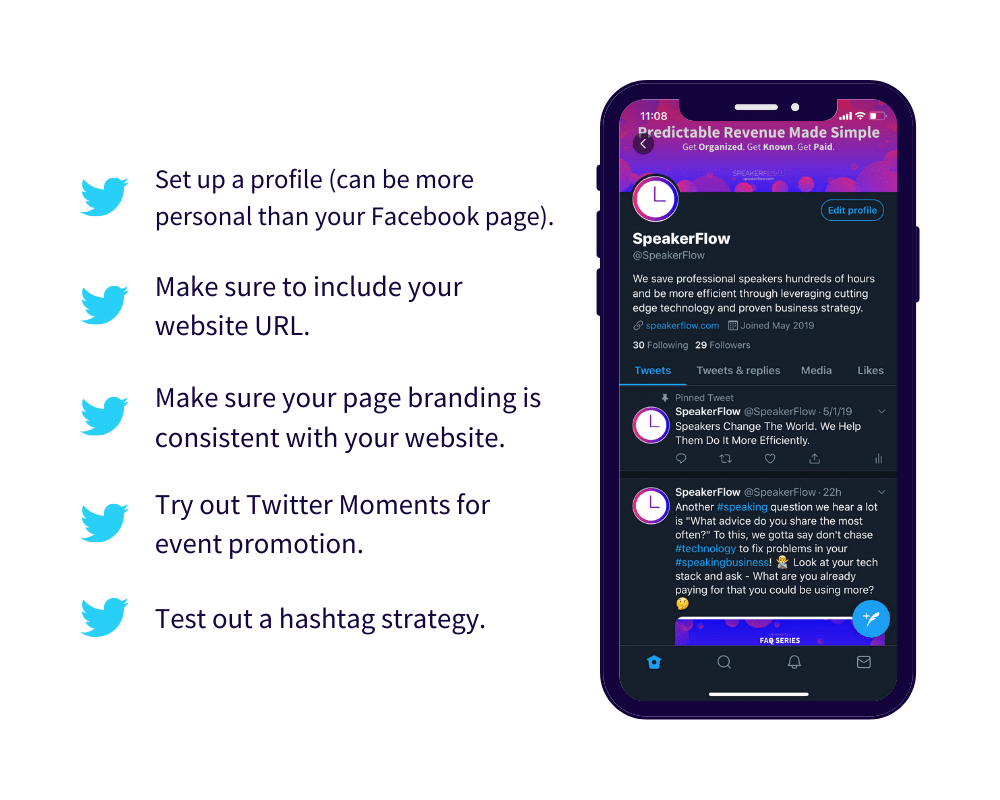
After Facebook, let’s move on to Twitter. Like Facebook, when it was originally launched by Jack Dorsey, Noah Glass, Biz Stone, and Evan Williams in 2006, Twitter was intended to act as a platform for personal connections. Allowing for only 280 characters per post, the interface is best used for succinct messages and thoughts. This originally made it the perfect platform for sharing personal thoughts and opinions and breaking recent news. Because it’s considered socially acceptable to post more than once a day on Twitter, or “tweet,” rather, this trend has continued into the present.
That said, in addition to personal thoughts and news, in recent years, Twitter has been used more and more for business news as well. For better or for worse, with the election of Donald Trump to the US Presidency in 2016, the world saw Twitter used for the first time as a way to communicate to the masses, share personal and professional ideas, and influence public opinion.
In your speaking business, the same principles and opportunities apply. Although on a smaller scale, using Twitter effectively to market yourself as a speaker allows you to reach a broad audience and share your message with them. Just as with Facebook, using Twitter means setting up a unique profile for your speaking business, keeping it consistent with your brand, and posting regularly. On the flip side, unlike Facebook, you can tweet more than once daily, making it especially useful if you’re promoting an event while on site.
Using Hashtags in Twitter Posts
Twitter is also similar to Facebook in its use of hashtags in each post. Arguably, Twitter was the first major social media platform to use hashtags. Because of this, it’s important that not only your tweets as a whole are tailored to your message, consistent, and on-brand. Your hashtags also need to meet these criteria. It’s also important, as with the use of hashtags on any social profile, to test out those that work best for your speaking business. Remember, while hashtags like #professionalspeaker and #keynotespeaker are fine, they’re also used all the time. Throw in a few unique ones to add some of your own style or try using them contextually, rather than including them all at the end in a string. Depending on your followers, one approach may be better than another, and you may just not know it yet.
More information about creating and managing a Twitter account can be found in the articles below. Twitter’s business blog, in particular, has a plethora of helpful guides besides the one included below, if you’re looking for additional tips and tricks.
- “Twitter Marketing in 2021: The Ultimate Guide” from HubSpot (my personal favorite)
- “Twitter For Small Businesses: How To Grow In 2022 And Beyond” from Buffer
- “The Dos And Don’ts Of Hashtags” from Twitter Business
Pro Tip: While Donald Trump’s use of Twitter is notable in many ways, remember that you don’t need to capitalize full words, as from a purely grammatical standpoint, that looks bad. Remember also to keep things brief. If your message is too long for a single tweet, condense it so that it fits the character limit. This makes your message more likely to be read and more memorable for the reader. 👌
Instagram Strategy Basics
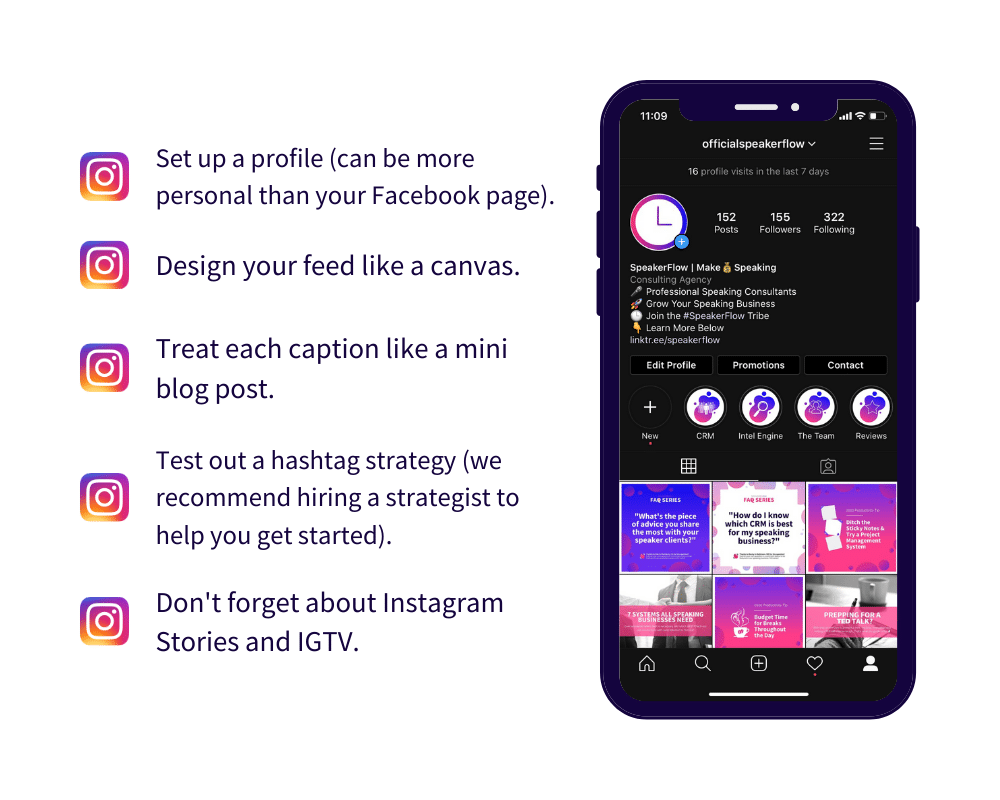
Of the social platforms we’ve discussed, although each is changing constantly, one more than any other is still growing in popularity. I’m talking about the almighty Instagram. Founded in 2010 by Kevin Systrom and Mike Krieger, Instagram is the newest of the four main social platforms we’ll break down in this guide. Like Facebook and Twitter, Instagram was created for personal use, originally, and has since blossomed into a massive network for businesses as well. Because of this, many of the strategies used to market yourself as a speaker on Facebook and Twitter also apply here. These include, once again, creating an account specific to your speaking business rather than your personal affairs, posting regularly, and tailoring every post, image, and video to your personal brand.
However, unlike Facebook, Twitter, and LinkedIn, Instagram requires that every post include an image or video. Because of this, your Instagram posts don’t just need engaging captions. They also need engaging and diverse content. In fact, because of Instagram’s requirements for visual components, when building your account, think of your profile page like a canvas. When someone visits your profile page, they should be able to see your brand colors and general style as they scroll through your feed. Are you more modern when it comes to your personal style, or more traditional? Are you a “bright colors” kind of person or more “subtle and dark”? Through the design of your Instagram posts, you can not only answer these questions and show a bit of your personality. You can also catch people’s attention, so they want to dive deeper into your profile. Win win!
Using Hashtags in Instagram Posts
Additionally, just as with Facebook and Twitter, you can also attract attention on Instagram through the use of hashtags. Hashtags on Instagram can be used to (a) reach a wider audience than would normally see your account and (b) consistently show up within a given niche or industry. For example, if you search for “#speakingbusiness” on Instagram, you’ll find a ton of posts from Jane Atkinson. As the owner of Speaker Launcher and the Wealthy Speaker School, Jane uses this hashtag to get in front of people looking for speaking business information. From there, through the content of their posts, they say, “Hey, we can help!” In the context of event planners, you can do the same thing!
All of that said, when using hashtags, there are a few things to remember. First, rather than using 2-3 hashtags contextually like on Twitter, on Instagram, you can include up to 30 hashtags per post. Ideally, you should add a comment below your post with your hashtags all together in a paragraph. That way, they don’t distract from your caption but you can still “rank” for them. After that, just remember to test continuously. The more you can try out new hashtags, the more likely you are to get in front of the right people.
To learn more about using Instagram to market yourself as a speaker, check out the sources below. If you’re completely new to Instagram, I recommend looking at Hubspot’s Instagram marketing guide first.
- “Instagram Marketing” from HubSpot
- “6 Instagram Marketing Trends You Need To Know In 2022” from Later.com
- “How To Create Instagram Content That Shines In 2022” from Instagram Business
- “The Ultimate Guide to Instagram Hashtags for 2022” from HubSpot
LinkedIn Strategy Basics
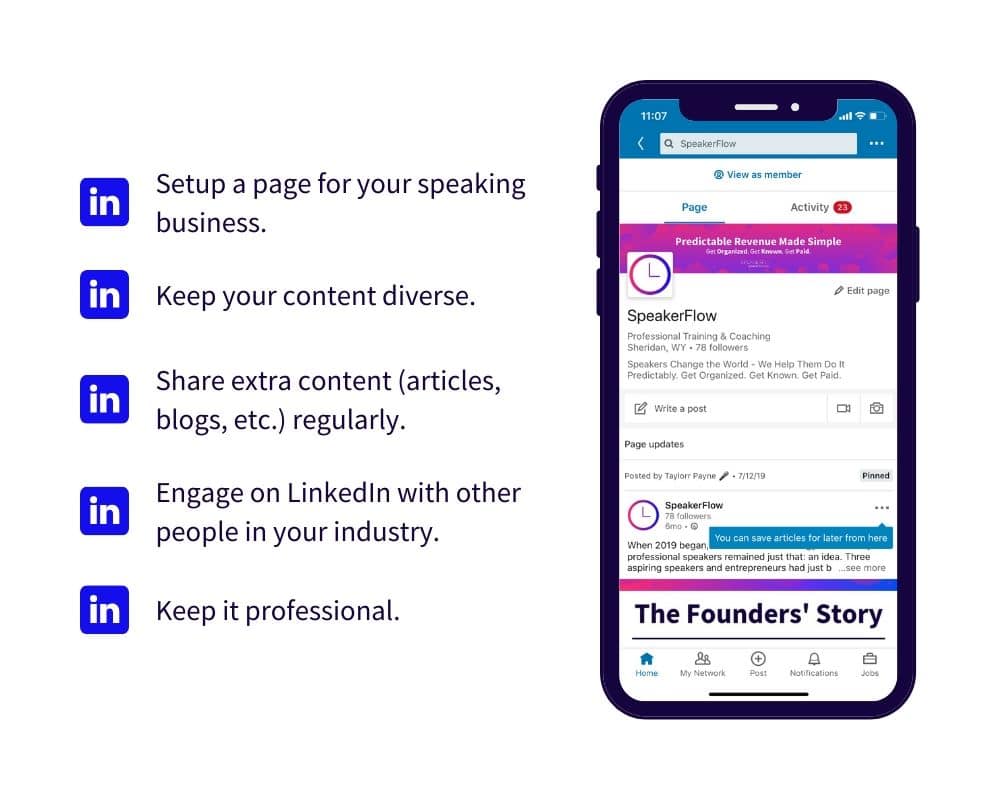
Last but not least, let’s not forget LinkedIn! Unlike Facebook, Twitter, and Instagram, LinkedIn is and has always been, first and foremost, a professional community rather than a personal one. Since it was launched in 2003 by Reid Hoffman, LinkedIn has grown to more than 660 million users worldwide. Because of this, their mission to “connect the world’s professionals to make them more productive and successful” has exploded, creating a vast web of connections across the globe. As you begin to use LinkedIn to market yourself as a speaker, the same extensive network available to all of those users also opens to you. This makes it easier than ever to get your name and profile in front of event planners, nationally or internationally.
To begin, using LinkedIn as a marketing platform requires a company page (separate from your personal LinkedIn profile), consistent branding and posting, and diverse content. However, because of LinkedIn’s professional focus, highlighting your credentials is especially important. Unlike your profiles on the other social platforms we’ve covered, your LinkedIn profile has specific sections for outlining your work experience, awards, and certifications, both as a speaker and an expert in your focus industry. Additionally, just like people can leave reviews on your company Facebook page, people can review you, as a professional, on your LinkedIn profile page.
Combined, your accolades and the recommendations of others make your profile a powerful tool in selling to event planners. When posting on LinkedIn, you can also add to your credibility independently by sharing or writing articles geared towards your target audience. In short, the more others are raving about you and the more you can show your skills, the more confident event planners who look at your profile will be (i.e. the more likely they’ll hire you).
Using Hashtags in LinkedIn Posts
Finally, as with the other social channels we walked through, you can also use hashtags on LinkedIn. Unsurprisingly, the same benefits of using hashtags elsewhere also apply on LinkedIn, including appearing in front of decision-makers or connecting with past audience members. However, just like posting on LinkedIn, it’s important that your hashtags have a professional focus rather than a personal one. So, for example, while the hashtags “#CareerEndingTwitterTypos” or “#WhyIQuit” might be funny in a Twitter post, they’re not appropriate for LinkedIn.
It’s also recommended that, rather than using hashtags contextually, as seen on Twitter, hashtags on LinkedIn and Facebook can also be included at the end of the post. This is partly due to the greater number of characters allowed on LinkedIn and Facebook. However, it also allows you to more easily add hashtags without distracting from your caption. It’s kind of like hashtags on Instagram, where you can add them all outside of your caption (although hashtags on LinkedIn aren’t nearly as important as on Instagram, when it comes to marketing).
Additional information for both posting on LinkedIn and using hashtags in your posts can be found in the articles below. Again, keep in mind that your own testing can be equally useful, especially where hashtags are concerned. In the speaking industry, there isn’t a ton of research for how to use social media for attracting event planners’ attention (yet). In truth, you’re part of the group paving the way! 🙂
- “LinkedIn for Business: The Ultimate Marketing Guide” from Hootsuite
- “How to Market on LinkedIn: Top 10 Tips for Using LinkedIn for Marketing” from LinkedIn Marketing Solutions
- “The Complete Guide to Using LinkedIn Hashtags” from Hootsuite
Showcasing Your Message & Brand

Above all, when using social media to market yourself as a speaker, everything should emphasize your message and brand. That includes the cover photo on your Facebook page, the tiles on your Instagram profile, and your biography on each platform. Every detail on your page plays a role in creating an experience for the person visiting your page or profile. As a result, each has to be carefully and intentfully designed and updated.
For example, looking at the SpeakerFlow Instagram page, you can tell a few things about us right away. First, you can see our purpose, “Make💰Speaking” so that you know exactly what we aim to help you do. Below that, you can see other details about us or actions you can take, including “Grow Your Speaking Business” and “Join the #SpeakerFlow Tribe”. Finally, at the bottom of our bio, you can see a link to our LinkTree page. Although you don’t necessarily need to use LinkTree, we chose it rather than simply including our website URL. That way, when people open our LinkTree page, they have direct access to more specific information related to SpeakerFlow, including our blog and our products.
These features, combined with our bright color scheme and casual language, tell a story about our brand. Not only are we locked and loaded with knowledge of the speaking industry and the best technology in it. We’re also more than happy to share it with anyone that asks. In the same way, the colors, language, and overall design of your social profiles should show who you are and why you’re great. That way, whether the person looking at your profile is ready to hire you or not, they’ll click the “Follow” button without hesitation.
Paid Advertising vs. Search Engine Optimization
Besides using social media to market yourself as a speaker, there are two other stellar ways to bring traffic to your website: paid advertising and search engine optimization (SEO). Depending on your focus industry, your budget, and the size of your team, each of these options can be beneficial for your speaking business for different reasons. However, by understanding the pros and cons of paid advertising and SEO, you can effectively use both in the future, even if one option is out of the question right now.
Pros & Cons of Paid Advertising
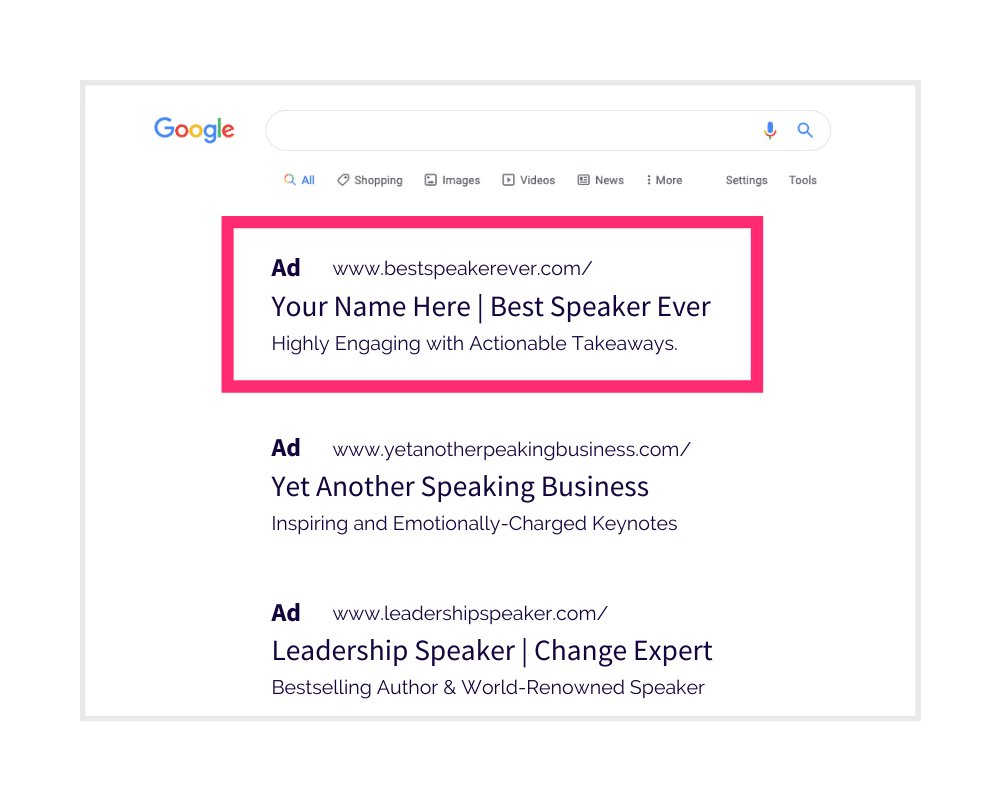
On the flip side of paid advertising, search engine optimization (SEO) allows you to market yourself as a speaker free of charge. If you’re new to SEO, in short, it involves designing your content and your website with keywords, key phrases, and layouts suited to search engines. For the most part, SEO focuses on optimization for Google searches, simply due to the volume of people that use Google. However, regardless of the platform you’re using and the content you’re designing, the benefits of high-quality SEO remain the same.
Additionally, once you’ve used advertising as a part of a long-term plan to market yourself as a speaker, the data you can gain from it is unmatched. From understanding which ads are attracting the most visitors to where those visitors are most active, you can learn a lot from advertising data. That said, when it comes to data, that’s where some of the cons to paid advertising come in. For the most part, collecting that useful data takes anywhere from 3-6 months. Because of this, in order to effectively and sustainably start a paid advertising campaign, you have to be willing to spend that 3-6 months of ad spend knowing you won’t see a return until month seven.
Our Recommendations
Taking all these things into account, as a general rule, we recommend paid advertising if you are an established speaker and have consistent predictable revenue from your speaking business. In other words, if your sales aren’t consistent yet, put a pause on paid advertising until you have that well in hand. As a side note, we have an ultimate guide to speaker sales, too, so you can start there and kick off paid ads when you’re ready. 😊
For now, if you do have sales locked down and are ready to get started with paid advertising, Google’s Skillshop is an easy and detailed place to start the learning and implementation process, if you’re not hiring a firm to manage your paid advertising for you. With courses in Google Analytics, Google Ads, and Google Ad Manager, their database has all the tools you need to launch Google ads with confidence. Additionally, for even more educational content, you can’t go wrong with WordStream’s blog. Within our team, our chief marketing and technology officer references their articles regularly. That way, he can keep up with trends in the paid advertising world – including excluding Google ads – while also keeping track of his other projects.
Pros & Cons of SEO
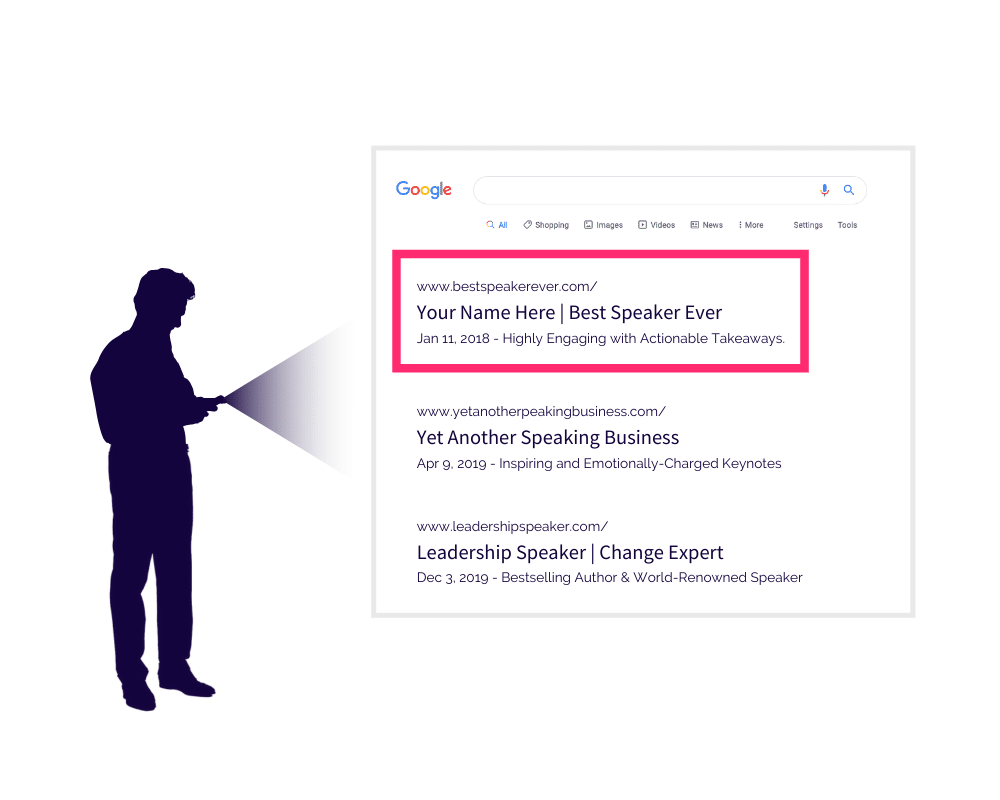
On the flip side of paid advertising, search engine optimization (SEO) allows you to market yourself as a speaker free of charge. If you’re new to SEO, in short, it involves designing your content and your website with keywords, key phrases, and layouts suited to search engines. Primarily, SEO focuses on optimization for Google searches, simply due to the volume of people that use Google. However, regardless of the platform you’re using and the content you’re designing, the benefits of high-quality SEO remain the same.
First and foremost, investing time in SEO consistently results in greater traffic to your site from intentful visitors. That means more site visits from more people considering you for their event. In essence, this happens because people are generally searching Google with a problem in mind, searching for a solution. Because of this, if your website or a page on your site is tailored to appear on the first page of search engine results, they’re more likely to see that you are the solution, and they need to hire you to help solve their problem. Sounds pretty great, right?
The bad news comes, again, in terms of time. Like paid advertising, SEO doesn’t immediately produce results, even if you’re investing a ton of time and energy in it. In fact, as a rule, it takes a minimum of six months to see traction in your SEO strategy and up to 18 months for a blog to fully actualize. In other words, even after you write a blog with keywords your audience is searching for (we’ll talk about this shortly), your blog won’t show up on Google right away. This is part of the reason that, in many industries, marketers are saying not to bother with SEO, even though you definitely should!
Our Recommendations
Admittedly, investing time in a solid SEO strategy takes diligence and consistency. However, the traffic your website will gain as a result of SEO remains consistent and predictable after those initial 18 months, making it well worth the time and effort regardless of the size or age of your speaking business. We’ve seen this in our business since we launched in May 2019. Initially, after launching our website and making sure its pages were SEO optimized, we were getting about 30 impressions per day. Now, more than six months later, that number has climbed to almost 2,000 impressions per day, largely from our content and SEO strategy.
When you market yourself as a speaker and focus on SEO, the same level of traction is possible in your speaking business. To start, I recommend checking out NeilPatel.com, managed entrepreneur and marketer Neil Patel, and Backlinko.com, run by internationally recognized SEO expert Brian Dean. Both of these websites are great starting places that provide actionable advice for anyone new to the world of SEO. They’re also incredible sources of information about rising trends and SEO strategies. So, when you’re managing the puzzle pieces of your speaking business later this year, the Neil Patel and Backlinko teams can email you the latest and greatest ways to rank on Google. That way, you can put them into practice without missing a beat.
Outlining A Content Strategy
The final piece of the puzzle, when planning to market yourself as a speaker, is content. This includes blog posts, articles – all of the publications that showcase your experience as a speaker and your credibility in your target industry. Besides making you a better writer with time, there are plenty of benefits that come from writing content. I’m talking about increased traffic to your website, high-quality educational content for you to share on your social media profiles – everything we covered in the last section when it came to SEO.
But, how do you make the most of your content, when beginning to market yourself as a speaker? I’m not going to lie. It’s not easy managing a content strategy on top of the rest of your speaking business. Throw in traveling from one speaking gig to another, and to say you have your hands full becomes an understatement. Luckily, next, we’ll walk through all of the SpeakerFlow tips to quickly and easily get started. 👍
The Basics of Keyword Research
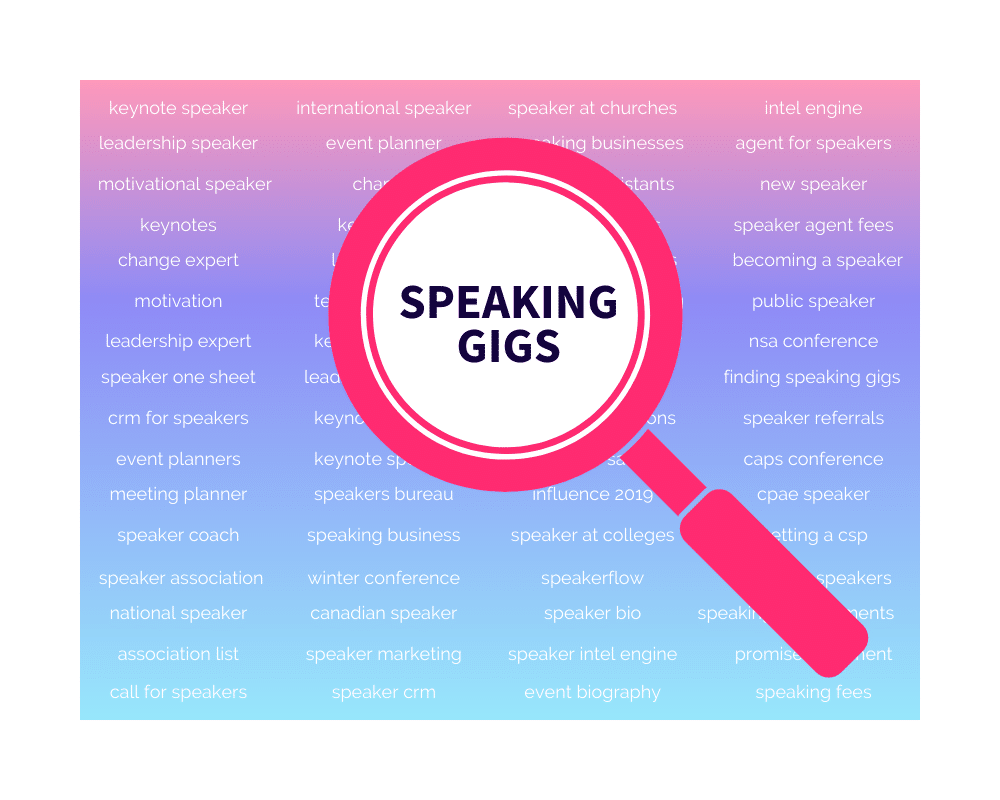
To begin, before writing a blog or creating a video, it’s important to verify your topic is useful. As a speaker, one of the amazing impacts you have is inspiring people from the stage. In the same way, choosing effective topics to write about allows you to do so from home. These topics are called “keywords” or “key phrases” and you use them every time you use a search engine, whether you know it or not.
For example, if you search “speakerflow” in Google, several results show up, including our website, YouTube channel, and social accounts. In this case, the keyword is “speakerflow” and each result has been designed to use that keyword regularly. Because of this, when you search for that keyword, Google’s algorithm recognizes all of our pages that use it, making them show up in the list of search results. Makes sense, right?
Similarly, when you’re looking for keywords, the easiest way to start is a simple Google search. Choose a keyword or phrase that you want to use when you market yourself as a speaker. A few examples of this are “generational speaker” or “leadership speaker”. After you’ve searched for a keyword, scroll to the bottom and look for the “Searches related to” section. Here, everything listed is another keyword you could rank for, on your blog, a landing page, anywhere online.
Admittedly, this is a bit oversimplified, and there are a handful of tricks to make keyword research simple and stress-free. Check out Backlinko’s “Keyword Research Strategies” guide and definitive keyword research guide to walk through them in detail.
Key Features of a Good YouTube Strategy
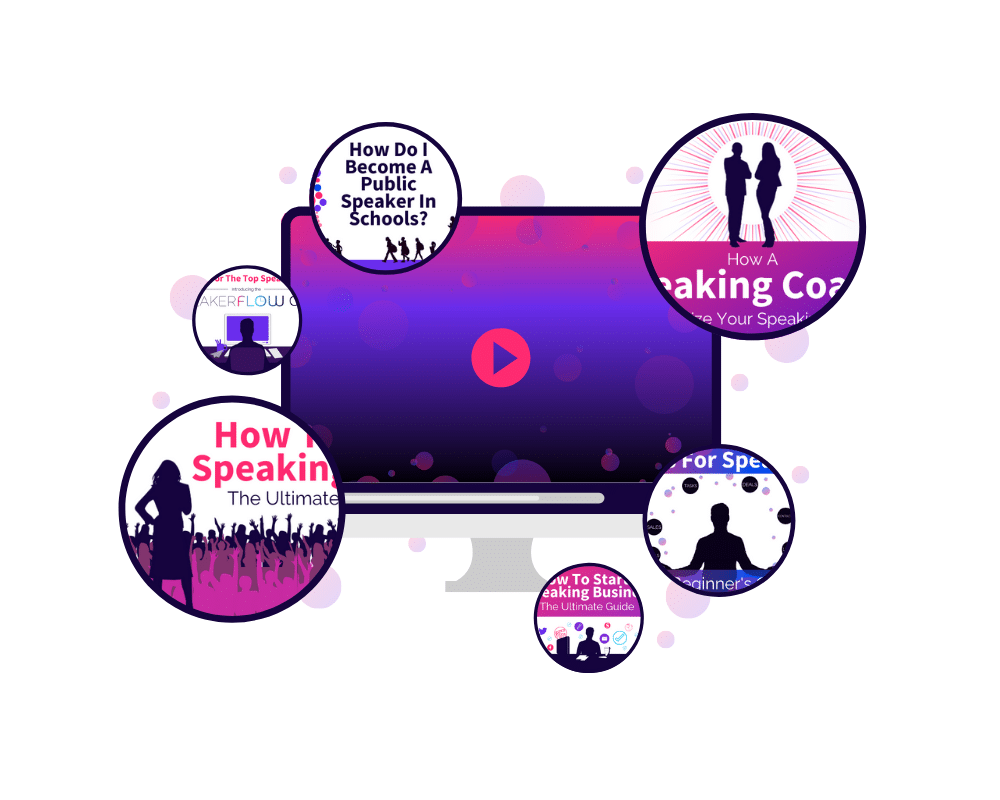
After you’ve identified keywords, it’s time to put them into action. One of the ways to do this is through YouTube videos. Since Google acquired YouTube in 2006, videos have not only become more accessible. They’ve also been prioritized by search engines because of their engaging nature. As a speaker, this provides you with some unique advantages. To begin with, you’re likely comfortable in front of people, so recording a presentation should be a piece of cake. Additionally, with keyword research, you’re also aware of the things people are searching for. Essentially, a good YouTube video combines both of these things. Using them, you can find people searching for your message and then reel them in with your killer stage presence.
To create a solid YouTube video, there are a few important things to include so your video is SEO optimized. First, include your keyword in the title of your video. That way, when people search for your keyword, they’ll see your video at the top of the list. They’ll also see that the title uses exactly what they’re looking for, making them more likely to click. Likewise, the second major component of a good YouTube video is using the keyword in the video itself. I know this seems common sense, but you’d be surprised how many people forget about it. Finally, don’t skimp on the thumbnail for your video. Just like images in social posts, the more eye-catching your thumbnail, the more likely someone will watch your video.
For more information about creating a solid YouTube strategy, I highly recommend following Nate Woodbury. Not only is his website an awesome example of good SEO. His YouTube channel is jam-packed with ways to grow your own.
Key Features of a Good Blog Post
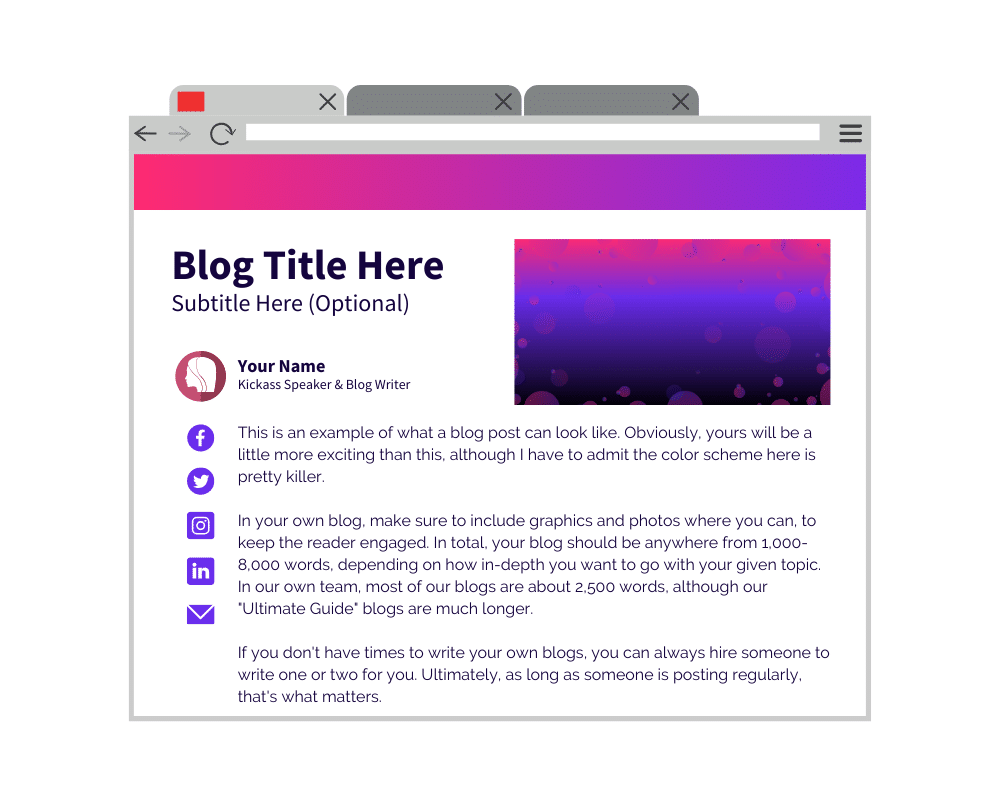
Alternatively, if you’re more of a writer than a speaker, when offstage, another way to reach people is through blogs. Like SEO as a whole, writing blogs can be time-consuming and stressful depending on your comfort as a writer. However, blog-writing is also like SEO in its worth over time, especially in the speaking space. Want to show an event planner how knowledgeable you are in their industry? Need something to include in an advertisement for your website? A blog can do both of these things on top of boosting the authority of your website. Plus, they make great shareable content for your social media accounts. What’s not to love about that?
When writing blogs, using them to market yourself as a speaker requires a few tactics up your sleeve. First and foremost, don’t skimp on the length of your blog. Ideally, each blog should be at least 1,500 words, and your keyword should make up 1-2% of those. Second, to break up those words, SEO experts generally recommend including graphics or videos throughout your blog. On top of making it easier to digest the content of your blog, including visuals also makes it more memorable. Plus, readers can share your graphics, leading anyone who sees them right back to your website.
For a full list of the components of a good blog post, once again, I have to recommend Backlinko. Every year, they release a killer guide to content writing, and the most recent was another win. Check it out for the finer details of an exceptional blog. It’ll have you working through your keyword list in no time.
Building a Content Calendar

At this point, we’ve covered a ton of information in this guide. From social media to keyword research, we’ve covered the A-Z of how to market yourself as a speaker. That said, you might be wondering, “How am I going to stay on top of all of this?” Fortunately, that’s where a content calendar comes in.
Before anything else, we at SpeakerFlow use our content calendar to store our list of keywords. That way, we can keep track of them and delegate them to different members of the team, if needed. We also use our content calendar for the “calendar” part. In the same way, as you use content to market yourself as a speaker, your content calendar is your mission control. When you’re writing a blog, recording a YouTube video, or posting to social media, it’s your checklist. Basically, if we mentioned it in this guide, you can organize it in your content calendar.
Within our team, we religiously use Asana for managing our content calendar. Although it’s our project management system for everything, it’s indispensable for planning content. This is largely because of the large task checklist we have for each blog. Likewise, for the same level of detail and organization in your speaking business, you can preview the template for free.
Hopefully, this guide provided you with the confidence and the tools to market yourself as a speaker. For more information about building a speaking business, check out our companion guides, “How To Get Speaking Gigs” and “How To Start A Speaking Business”.


